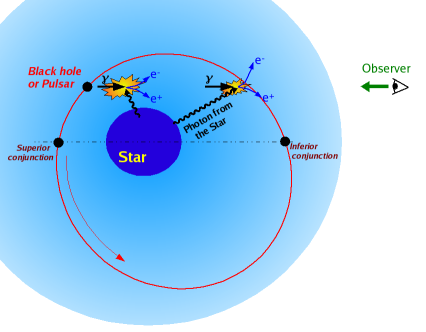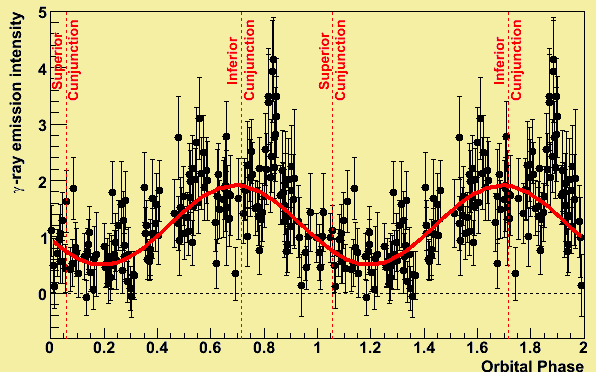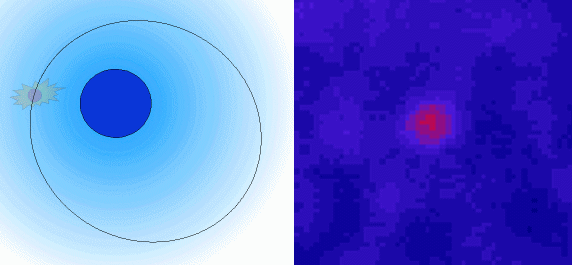The H.E.S.S. international collaboration has announced, in the latest edition of the journal Astronomy & Astrophysics (link to PDF), the discovery of periodic emission of very-high-energy gamma rays coming from a binary system LS 5039. In our Galaxy, more than 80% of the stars are members of multiple systems (double, triple...) made up of several stars in orbit about each other. Isolated stars, such as our Sun, are in the minority. The system LS 5039 (see the adjacent figure) is made up of a massive blue star around which orbits an as-yet unidentified compact object, possibly a black hole.
These two objects are in an extremely tight orbit. Their separation varies between two and four times the radius of the star (which represents about a tenth of the Earth-Sun distance) with an orbital period of 3.9 days, confirmed to a precision better than 0.04% by H.E.S.S.
The H.E.S.S. team showed that the LS 5039 system emits gamma rays with a certain periodicity, with the highest emission when the compact object is in front of the star, and the lowest (but not zero) emission when it is behind (see figure below). "Additionally, we discovered that the energy distribution of gamma rays varies strongly along the orbit, with an excess of the highest-energy gamma rays in the high-emission state," notes H.E.S.S. researcher Gavin Rowell (then working at the Max Planck Institute for Nuclear Physics, MPI-K).
This gamma-ray emission could be produced by the violent interaction between the compact object and the stellar wind. This wind is the flux of particles accelerated in the star’s atmosphere which causes, in the case of our Sun, magnetic storms and the aurora borealis or "Northern lights" seen near the Earth’s poles. The compact object, in moving along its orbit, acts like a probe of the star’s electromagnetic environment: of the intensity of the star’s wind and its optical and ultraviolet radiation, and of the magnetic field which changes depending on the distance to the star and which influences the particle acceleration process near to the compact object. Another implication of this discovery is that the particle acceleration responsible for the emission takes place at a short distance from the star, at distances similar to the Earth-Sun distance.
In addition, a geometrical effect adds a further modulation to the flux of gamma rays observed from the Earth. We know since Einstein derived his famous equation (E=mc²) that matter and energy are equivalent, and that pairs of particles and antiparticles can mutually annihilate to give light. Symmetrically, when very energetic gamma rays meet the light from a massive star, they can be converted into matter (an electron-positron pair in this case). So, the light from the star acts like a fog for gamma rays, absorbing them especially when their source — the compact object — is behind the star, and so is partially eclipsed. "The periodic absorption of gamma-rays is a nice illustration of the production of matter-antimatter pairs by light, though it also obscures the view to the particle accelerator in this system" explains Guillaume Dubus, Astrophysical Laboratory of Grenoble, LAOG.
The modulation seen with H.E.S.S. is therefore likely to be caused both by a variation in the particle-acceleration process along the orbit and also by the geometric effect due to the "light-fog". "This is the first time in the history of very high energy gamma-ray astronomy that we can observe a repeating, evolving, particle-acceleration experiment in a well-determined environment" says Mathieu de Naurois, Nuclear and High-Energy Physics Laboratory, LPNHE, Paris.
The discovery by the H.E.S.S. collaboration of this orbital clock, thanks to the precision of the measurements, will open the way to a better understanding of the environment of black holes, neutron stars, and more generally of the sites of particle acceleration in the Universe.



